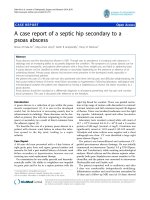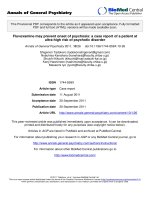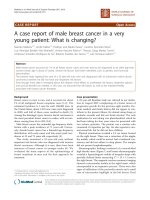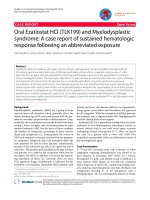A case report of acute pancreatitis associated with pancreaticobiliary maljunction
Bạn đang xem bản rút gọn của tài liệu. Xem và tải ngay bản đầy đủ của tài liệu tại đây (622.6 KB, 5 trang )
Hue Central Hospital
A CASE-REPORT OF ACUTE PANCREATITIS ASSOCIATED
WITH PANCREATICOBILIARY MALJUNCTION
Vo Dai Dung1, Nguyen Tuan Ngoc2, Le Kim Long2, Le Nguyen Khoi1
ABSTRACT
Background: Pancreaticobiliary maljunction (PBM) is a rare congenital anomaly and possess potential
risk of cancer.
Aims: To present of a case of acute pancreatitis associated with PBM and review the literature.
Method: Case-report study.
Results: A case of 16 years old female presented with acute pancreatitis and common bile duct (CBD)
stones. The main features were abdominal pain, increased serum pancreatic enzymes and abnormal liver
function tests. CT-Scan, MRCP and ERCP detected common bile duct dilation (10mm), long common
channel (3-4cm) and suspected common bile duct stones. The patient was operated by laparoscopic
surgery with gallbladder-CBD excision and Roux-en-Y hepaticojejunostomy and was discharged in a good
condition.
Conclusions: PBM should be considered as a potential cause of recurrent pancreatitis, especially in
young patients. The risk of cancer is well validated and needs appropriate management.
Key words: Pancreaticobiliary maljunction
I. INTRODUCTION
Pancreaticobiliary maljunction (PBM) is a rare
congenital anomaly where the pancreatic and bile
ducts join outside the duodenal wall. Consequently,
pancreatic juice communicates freely with bile
duct and may lead to multiple complications such
as: cholangitis, pancreatitis and biliary cancer5.
PBM is frequently associated with congenital
biliary cyst. If without biliary dilatation, the
clinical presentations are usually non-specific
and so easily missed. Hence, we present a case of
acute pancreatitis associated with PBM that was
incidentally detected and then operated at Trưng
Vương hospital.
1. Trung Vuong hospital
2. Pham Ngoc Thach Medical University
II. CASE PRESENTATION
A patient of 16 years old female was hospitalized
for recurrent acute pancreatitis.
Laboratory examinations at hospitalization
Table 1. Laboratory examinations at
hospitalization
Laboratories
Value
WBC
16.94 K/µL
RBC
4.00
M/µL
Hb
11.9
g/dL
Bilirubin T
131.9 µmol/L
Bilirubin D
77.9
µmol/L
Bilirubin I
54
µmol/L
AST
170
U/L
ALT
249
U/L
Amylase
464
U/L
Lipase
709.08
U/L
Corresponding author: Le Nguyen Khoi
Email:
Received: 10/5/2019; Revised: 17/5/2019
Accepted: 14/6/2019
Journal of Clinical Medicine - No. 54/2019
71
A case-report of acuteBệnh
pancreatitis
viện Trung
associated...
ương Huế
Imaging at hospitalization
US: Intra / Extra hepatic biliary dilatation
CT scan: Intra / Extra hepatic biliary dilatation,
suspected CBD stones 5mm and abnormal
pancreatic duct
Pre-operative Imaging to confirm PBM
- MRCP: Intra / Extra hepatic biliary dilatation,
CBD stones and PBM (Fig. 1)
- ERCP: Normal papilla of Vater, CBD stones,
abnormal junction between pancreatic duct and
CBD situated 4cm proximal to papilla of Vater.
- Choledochotomy and cholangioscopy: Some
stones of 3-4mm in CBD, pancreatic duct and
common channel. The junction of pancreatic duct
and CBD was identified exactly similar to previous
diagnostic images (Fig. 3). The stones were smooth,
light gray-yellow color, and friable, like protein
plug. The sphincter of Oddi was patent with softly
contraction, the rest of biliary tree was smooth
without stenosis and stone.
Fig. 1- MRCP
Laparoscopic surgery was indicated for biliary
pancreatitis with suspected PBM.
The intra-operative modalities utilized to
confirm PBM
- Dosage of pancreatic enzymes in CBD bile:
Amylase / Bile:
103751 U/L
Lipase / Bile:
545564 U/L
- Intra-operative cholangiography via CBD:
PBM, long common channel with 4cm length
similar to MRCP (Fig. 2)
Fig. 3- Identification of pancreaticobiliary
junction with cholangioscopy
Bile duct and pancreatic duct were then irrigated
for clearance of stones. Cholecystectomy and
extrahepatic duct resection were performed with the
proximal end at hepatic duct and the distal end at
5mm proximal to pancreaticobiliary junction. The
biliary was reconstructed by Roux-Y bilioenteric
anastomosis.
Postoperative recovery was normal, the patient
was discharged uneventfully. Pathology result was
chronic inflammation of gallbladder and bile duct.
Fig. 2- Intra-operative cholangiography
72
III. DISCUSSION
PBM with the pancreaticobiliary junction located
outside the duodenal wall, and the sphincter of Oddi
cannot exert any influence or control on the junction
(Fig. 4). The free flow and reflux between pancreatic
juice and bile may result in many consequences:
pancreatitis, cholangitis, cancer of the gallbladder
and bile duct.
Journal of Clinical Medicine - No. 54/2019
Hue Central Hospital
Fig. 4- PBM
(Source: Kamisawa, 2012) [5]
The diagnostic criteria of PBM in the literature
are: pancreaticobiliary junction lies outside
the duodenal wall demonstrated by imaging or
anatomically by operation or autopsy. The signs in
imaging consist of: common channel longer than
1.5cm, the junction is located outside the duodenal
wall, and the sphincter fails to exert any effect on
the junction [5], [6].
The high pancreatic enzymes levels in the bile
duct and/or the gallbladder (usually > 10000U/L)
serve as an auxiliary diagnosis [5], [6].
We utilized the diagnostic modalities proposed
by many authors to confirm PBM: CT scan, MRCP,
ERCP, Cholangiography, and pancreatic enzymes
in the bile (except EUS) [5]. Particularly, because
of dilated CBD in this case, we performed also
cholangioscopy to identify the PBM and to examine
completely the biliary tree. All the results satisfied
the diagnostic criteria of PBM.
Normally, PBM is classified as PBM with
and without biliary dilatation. The PBM with
biliary dilatation is common and usually termed
“congenital biliary cyst” (especially type Ia, Ic and
type IVa), but in minor form the bile duct may be
slight dilated, unlike the “cystic” form [3], [5].
The diagnosis of PBM with biliary cyst
is practically not difficult due to its typical
presentation in both children and adults, and
eventually easily found on US or CT scan. On the
contrary, the diagnosis of PBM without biliary
dilatation or with slight dilatation is very easily
missed due to multiple atypical clinical situations:
pancreatitis, cholangitis, gallstones, in which
the usual imaging techniques (US, CT scan) are
incapable to find out PBM.
In presented case, initially PBM was not noticed
but the incidental finding of abnormal pancreatic
duct on CT scan forced us to realize additional
techniques to verify PBM.
PBM may be classified based on the pattern of
pancreaticobiliary junction (Komi’s classification).
Recently, a new pediatric PBM classification was
proposed by Japanese authors, including 4 types
(Fig. 5). According to this, our case is type B.
Fig. 5- Pediatric PBM classification
(Source: Urushihara, 2017) [7]
Journal of Clinical Medicine - No. 54/2019
73
A case-report of acuteBệnh
pancreatitis
viện Trung
associated...
ương Huế
The risk of biliary and gallbladder cancer is well
Kamisawa proposed to perform MRCP for
validated. According to Kamisawa, the prevalence
patients with gallbladder wall thickening on
of biliary tract cancers in adult PBM patients with
screening ultrasonography.
and without biliary dilatation was 21.6 and 42.4%
The incidence of PBM is relatively rare,
respectively. In PBM patients with biliary tract
approximately 1 in every 1,000 persons is affected
cancers, bile duct and gallbladder cancers were
by this disease in Japan [7], and this incidence is
present in 32.1 and 62.3% of patients with biliary
4.1% in South Korea (following 10,243 ERCP cases).
dilatation and in 7.3 and 88.1% of those without
However, once this condition is misdiagnosed, the
biliary dilatation respectively.
long-term consequences may be severe.
The preferred treatment of PBM with biliary
dilatation is cholecystectomy and extrahepatic bile
duct resection close to pancreaticobiliary junction and
Roux-Y hepaticojejunostomy (also called “biliary
diversion”), it’s exactly our choice in this case.
debate about the treatment of PBM without
biliary dilatation. In many institutes, prophylactic
is
sufficient
because
situations in which PBM should be screened:
- Acute pancreatitis with non obvious etiology,
recurrent pattern and young age
- Biliary dilatation on imaging without evident
On the other hand, there is considerable
cholecystectomy
Therefore, we try to propose certain clinical
cause
- Gallbladder wall thickening on screening
ultrasonography
most
- The cases of cholecystectomy for lithiasis
biliary cancers in PBM patients without biliary
or polyp, dosage of pancreatic enzymes in the
dilatation are gallbladder cancers. However, some
gallbladder should be performed
surgeons suggest that the extrahepatic bile duct
should be removed together with the gallbladder
in PBM patients without biliary dilatation for the
prevention of bile duct cancer [1], [8].
In patients operated with the above biliary
diversion procedure, the malignancy risk also remain.
- The cases of cholangiography, CT scan, MRCP,
ERCP for any reason, PBM should be screened
- The cases of intervention on bile duct, dosage
of pancreatic enzymes in bile and cholangiography
should be performed
- The cases of gallbladder or biliary cancer
In longterm follow-up, the incidence of biliary
cancer range 0.7%–5.4% [6]. Thus, the postoperative
IV. CONCLUSIONS
patients should be followed-up for life.
PBM is a rare congenital malformation (with
According to Kamisawa, PBM without biliary
high incidence in Asia), susceptible to misdiagnosis
dilatation rarely have symptoms, so that the majority
(especially PBM without biliary dilatation) and may
of such patients remain undiagnosed until they
have potential risk of cancer.
present with advanced-stage gallbladder cancer. So
The modalities and criteria for diagnosis of
the most important problem is creating a strategy
PBM are actually available at almost Vietnamese
for early detection of PBM and prevention of
hospitals.
cancer [8]. With our presented case, we found some
noticeable features as: recurrent pancreatitis and
young age (16 yrs), these are just the characteristics
of acute pancreatitis in PBM.
74
The treatment of PBM requires surgical
intervention and the follow-up is for life.
Our important task is to perform the best
screening strategy for early detection of PBM.
Journal of Clinical Medicine - No. 54/2019
Hue Central Hospital
REFERENCES
1. Jiro Ohuchidam MD; Kazuo Chijiiwa, MD, PhD,
Masahide Hiyoshi, MD; Kiichiro Kobayachi,
Hiroyuki Konomi, Masao Tanaka.Long-term
Results of Treatment for Pancreaticobiliary
Maljuntion Without Bile Duct Dilatation. Arch
Surg, 2006;141:1066-1070
2. Jin-Seok Park, Tae Jun Song, Tae Young Park,
Dongwook Oh, Hyun Kyo Lee, Do Hyun Park,
Sang Soo Lee, Dong Wan Deo, Sung Koo Lee,
and Myung-Hwan Kim. Predictive Factor of
Biliary Tract Cancer in Anomalous Union of
the Pancreaticobiliary Duct. 2016, Medicine
95(20):e3526.
3. Hiroki Ishibashi et al (2017). Japanese clinical
practice guidelines for congenital biliary
dilatation. J Hepatobiliary Pancreat Sci.: 448604. Terumi Kamisawa, Hisami Ando, Mitsuo
Shimada, Yoshinori Hamada, Takao Itoi,
Tsukasa Takayashiki, Masaru Miyazaki. Recent
advances and problems in the management
of pancreaticobiliary maljunction: feedback
from the guidelines committee. J Hepatobiliary
Pancreat Sci,2014, 21:87–92
5. Terumi Kamisawa et al (2012). Japanese clinical
practice guidelines for pancreaticobiliary
maljunction. J Gastroenterol, 47:731–759.
6. Terumi Kamisawa et al (2014). Diagnostic
criteria for pancreaticobiliary maljunction 2013.
J Hepatobiliary Pancreat Sci 21:159–161.
7. Naoto Urushihara (2017). Classification of
pancreaticobiliary maljunction and clinical
features in children. J Hepatobiliary Pancreat Sci
24:449–455.
8. Terumi Kamisawa, Goro Honda (2019).
Pancreaticobiliary Maljunction: Markedly High
Risk for Biliary Cancer. Digestion; 99: 123–125.
Journal of Clinical Medicine - No. 54/2019
75









